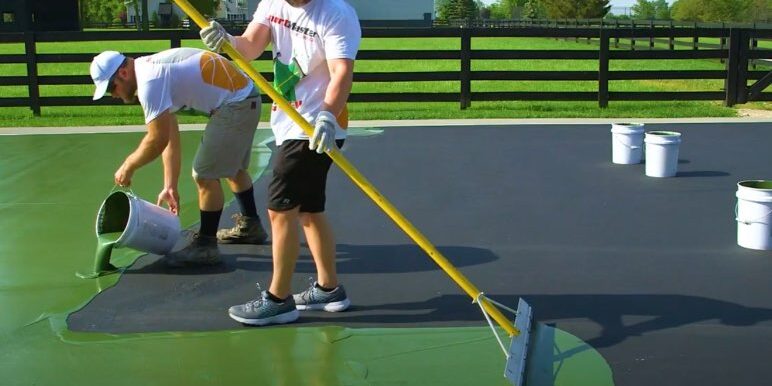Sustainable Practices in Pickleball Court Building And Construction You Should Know
As the appeal of pickleball remains to increase, so also does the demand for sustainable practices in court building and construction. This approach not just addresses environmental worries but likewise enhances the durability and performance of the courts. From selecting environmentally friendly products to applying efficient water drainage and energy-saving lighting remedies, there are various approaches to consider. The impact of these techniques expands far beyond the court itself. Understanding how each aspect adds to a more lasting future welcomes better expedition right into the elaborate balance in between recreational development and ecological stewardship.
Picking Eco-Friendly Materials
Selecting environment-friendly materials is an essential action in the building and construction of sustainable pickleball courts. The selection of lasting materials not only reduces environmental impact but additionally boosts the longevity and efficiency of the court. Key materials consist of reused rubber for the surface area, which uses exceptional sturdiness and shock absorption while diverting waste from land fills.
Additionally, making use of locally sourced materials decreases transport exhausts and supports regional economic situations. Pickleball court construction. Making use of indigenous woods for secure fencing and seats can give a lasting aesthetic while making sure durability against the elements.
Integrating permeable materials for court foundations can further add to sustainability by enabling natural water drainage and reducing overflow. These selections not just protect local ecosystems but likewise promote healthier play environments.
Efficient Water Drainage Solutions
While the choice of environment-friendly materials is necessary, implementing reliable water drainage services is just as critical for keeping sustainable pickleball courts. Appropriate water drainage not just safeguards the court surface from water damages yet likewise lessens disintegration and drainage, promoting environmental stability.
Efficient drain systems can include permeable paving, which allows water to infiltrate the ground as opposed to merging externally. This decreases the likelihood of standing water, which can result in mold and mildew and other maintenance issues. Furthermore, including purposefully positioned water drainage channels and swales can direct excess water far from the court area, guaranteeing a completely dry playing surface area and protecting against dirt disintegration.
Using native vegetation in the landscaping around the courts can even more boost drain by soaking up excess water and reducing drainage. These plants need less irrigation and advertise biodiversity, lining up with lasting practices.
In addition, it is important to frequently preserve the water drainage system to guarantee its long-term effectiveness. This includes cleaning debris and tracking for obstructions. By focusing on efficient drain solutions, pickleball court constructors can considerably add to the sustainability and long life of the facility, inevitably profiting both gamers and the environment.
Energy-Efficient Lighting Options
As the demand for pickleball remains to expand, incorporating energy-efficient lights options right into court layout has become progressively vital for sustainability. Standard lights systems commonly consume extreme energy, adding to greater operational costs useful link and ecological impact. As a result, embracing modern, energy-efficient technologies is important for both brand-new constructions and renovations.
LED (Light Emitting Diode) lighting stands out as a top selection because of its longevity and power cost savings (Pickleball court construction). Compared to conventional illumination, LEDs make use of about 75% much less energy and can last as much as 25 times longer, significantly minimizing maintenance prices. Moreover, the directional nature of LED lighting decreases light air pollution, ensuring that illumination is concentrated on the court as opposed to surrounding areas.

Sustainable Surface Area Alternatives
Exploring lasting surface area options for pickleball courts has actually gained grip among home builders and gamers alike. The emphasis on green materials not only straightens with the growing ecological awareness however also enhances the efficiency and durability of the courts.
One popular option is the use of recycled rubber, which can be sourced from used tires. This product gives outstanding shock absorption, minimizing try these out the risk of injuries for gamers while promoting sustainability. In addition, modular ceramic tiles made from recycled plastics provide one more viable option. These floor tiles are very easy to replace and set up, and their flexibility allows for various court configurations.
Natural lawn courts are also emerging as a sustainable selection, advertising biodiversity and reducing the warm island impact. However, they call for routine maintenance and water, which might not line up with all sustainability goals.

Water Conservation Strategies

One more efficient method entails the installation of rain harvesting systems. These systems store and collect rain for use in maintaining court surfaces and landscaping. This strategy not only saves potable water however likewise reduces reliance on municipal resources.
Moreover, using drought-resistant landscaping around the courts is crucial. Native plants require less water and are much better adapted to neighborhood climate conditions, hence decreasing general water consumption. web In addition, making use of reliable watering systems, such as drip irrigation, makes certain that water is provided straight to plant roots, reducing evaporation and waste.
Final Thought
Including sustainable techniques in pickleball court building and construction significantly adds to environmental preservation and resource efficiency. Using environment-friendly products, carrying out reliable drain solutions, and taking on energy-efficient illumination alternatives can greatly lower eco-friendly effect. Exploring sustainable surface choices and utilizing water preservation strategies enhance the general sustainability of these entertainment centers. By focusing on these practices, the construction of pickleball courts can align with wider environmental goals while promoting longevity and capability within neighborhoods.
As the popularity of pickleball continues to climb, so also does the demand for sustainable methods in court building and construction.Selecting green materials is a vital step in the building of sustainable pickleball courts. By focusing on energy-efficient illumination alternatives, pickleball court contractors can add to a much more sustainable future while meeting the needs of gamers and stakeholders alike.Incorporating sustainable surface alternatives not only enhances the performance of pickleball courts yet also leads the means for carrying out reliable water conservation strategies.Integrating sustainable techniques in pickleball court construction significantly adds to environmental preservation and source performance.